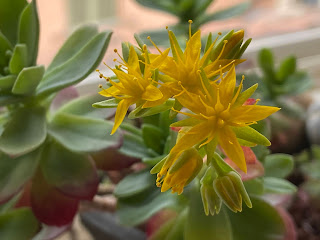

Left: The flowers of Sedum palmeri with 5 petals and 5 sepals.
Right: Sedum palmeri in a windowsill flower box in Bergamo, Italy.
S. palmeri is in the family Crassulaceae native to mountains of Mexico. It forms rounded cushions about 30 cm high and 40 cm wide. Leaves are arranged in rosettes located at the tips of stems. The golden yellow flowers bloom in spring and are abundant and long lasting. In fact, walking around a city like Bergamo, you are likely to notice the bunches of yellow S. palmeri flowers dangling over your head.
This sedum is relatively easy to grow, which leads to its ubiquitous nature. S. palmeri leaves are light green. In winter, the leaves can be tinged with red depending on their exposure to cold. In fact, S. palmeri can support suprisingly low temperatures. According to WorldOfSucculents, it can withstand temperatures as low as 0 °F or -17.4 °C, with a lower hardiness zone of 7a. In short, there is little wonder why this tough plant is such a popular ornamental succulent. From Mexico to Bergamo flower boxes: Sedum palmeri has come a long way baby.
In Italian, it's called Borracina di Palmer, where borraccina is the general name for a related and similar looking (flower-wise) stonecrop (sedum), Sedum acre.
All photos of Sedum palmeri in this post were taken in our palazzo. Our sedum plant (shown in flower close ups) was started from plant bits found on the ground after a storm.
Sedum palmeri was first described by the American botanist Sereno Watson (1826 - 1892). The specific epithet "palmeri" honors the self-taught British botanist and an early American archaeologist Edward Palmer (1829 - 1911). Palmer collected specimens in the southwestern United States, Florida, Mexico (including Baja California), and South America. About 200 species and two genera (Palmerella and Malperia) of plants are named in his honor. The standard author abbreviation Palmer is applied to botanical taxa he described.
A list of our wall plants of Bergamo thus far:
- [Crassulaceae] Sedum album and Sedum dasyphyllum (post) - White Stonecrop and Corsican Stonecrop
- [Papavero] Fumaria officinalis (post) – Earth Smoke
- [Brassicaceae] Aubrieta deltoidea - Purple Rock Cress and Iberis sempervirens - Evergreen Candytuft (post)
- [Geraniaceae] Geranium robertianum (post) - Stinking Bob
- [Asteraceae] Erigeron karvinskianus (post) - Mexican Fleabane
- [Aspleniaceae] Asplenium ceterach (post) - Rustyback Fern
- [Aspleniaceae] Asplenium ruta-muraria (post) - Wall Rue
- [Aspleniaceae] Asplenium trichomanes (post) - Maidenhair spleenwort
- [Urticaceae] Parietaria diffusa (post) – Pellitory
- [Plantaginaceae] Cymbalaria muralis (post) - Pennywort



Left: A typical planter of Sedum palmeri.
Center: Our Sedum palmeri plant, which usually sits outside this window.
Right: Sedum palmeri flower.
No comments:
Post a Comment
All comments are moderated. If your comment doesn't appear right away, it was likely accepted. Check back in a day if you asked a question.